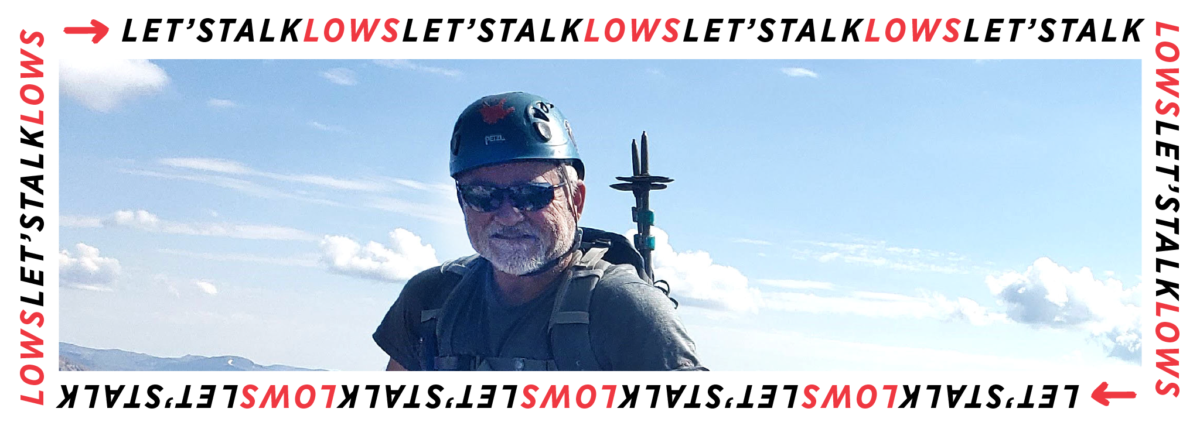Climbing Mountains and Surviving Lows
Editor’s Note: This week, Beyond Type 1 will be focusing on hypoglycemia and severe hypoglycemia during our Let’s Talk Lows campaign. We’re looking at causes, symptoms, fears and treatment options. Follow along using the hashtag #LetsTalkLows and share your hypoglycemia experiences with the community.
The good life
Michael Gaudet is 56 and lives in Berthoud, Colorado. A chemical engineer by trade, he is also an avid mountaineer and senior instructor at the Colorado Mountain Club, teaching classes and guiding excursions in the Colorado Mountains, often for days at a time.
Michael has lived with type 1 diabetes since 1977—he was diagnosed at 13 years old. Tools and treatments have obviously advanced since then, but Michael clearly recalls being told by his doctor at the time that he would probably only live to be 50. Still, immediately after he was discharged from the hospital, he remembers promptly going to a friend’s house to play basketball and says, “I haven’t looked back since as far as exercise goes. To me, that’s the key to everything.”
Since being diagnosed, Michael hasn’t let type 1 or anything else stand in the way of being active and achieving whatever sporting exploits he sets his mind to. He was an amateur bicycle racer for 25 years, then raced sports cars for eight, and for the last three years, has competed in power lifting competitions when he has time. “I have to have a goal. I like competing. I’m a competitive person, so just going to the gym wasn’t enough for me. I got into competitions, and I just love it. It’s very mental,” he says.
Getting in tune
Michael feels that his diabetes management has come with its own, less exciting set of challenges. About 15 years ago, he was also diagnosed with gastroparesis, a frequent complication of diabetes that can make the condition harder to manage. As a result, he encountered sudden difficulties like severe lows after not being able to digest food properly and recalls at least five times his wife Loni had to inject him with glucagon in the midst of an episode of severe hypoglycemia.
Having had this history of frightening lows, Michael made a point to fill a nasal glucagon prescription shortly after the new low treatment hit the market. And even though he had changed up his diet and gotten his gastroparesis under control, it was a good idea that he made a point to pick up Baqsimi because when he recently encountered another severe low, having it on hand made all the difference.
While driving home from a massage appointment, Michael’s usual low snack didn’t work to raise his blood glucose levels enough and he became so disoriented that he got into a fender bender. Thankfully, he had the wherewithal to call his wife to come to his aid and she was able to quickly administer the nasal glucagon when she arrived.
“She had no problems delivering it and 10 or 15 minutes later, my blood sugar had turned around. It seemed like to me it worked a little bit quicker than the injectable glucagon, from my experience,” Michael says.
Editor’s Note: Nasal glucagon has the same onset of action time as injectable glucagon, 5-10 minutes with blood sugars beginning to rise around 15 minutes.
Changing it up
While injectable glucagon did the trick in previous situations, Michael believes that nasal glucagon is definitely a game-changer and more in line with his personal goals and pursuits: “It’s great for the backcountry because it’s much more durable and it’s really easy to administer.”
He is even more excited now for wilderness trips to come, and knows he’d like to show his group how to use Baqsimi in the event that he or anyone else who might have diabetes needs it.
“I actually still have the old one and I’m going to use that as a demonstration for my wilderness first aid training,” he says. “Because I’m the one with type 1 diabetes, I always stand up in front of the group and tell them what to do if you have somebody with diabetes in the backcountry and they get low blood sugar. I’m really excited. I think anybody that’s leading trips should have something like this. If somebody has a low blood sugar and they can’t respond themselves, having this in your pack, it’s so easy.”
Educational content related to severe hypoglycemia is made possible with support from Lilly Diabetes (BAQSIMI), an active partner of Beyond Type 1 at the time of publication. Editorial control rests solely on Beyond Type 1.





